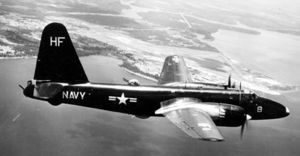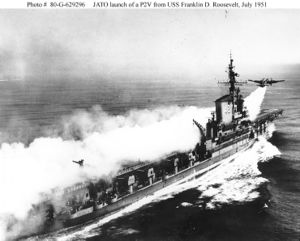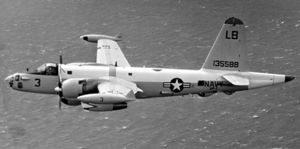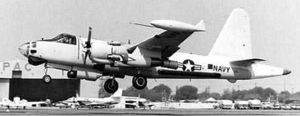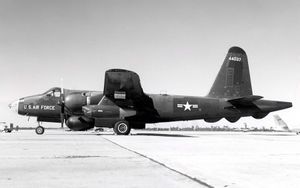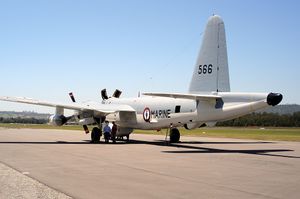PlaneSpottingWorld welcomes all new members! Please gives your ideas at the Terminal.
P-2 Neptune
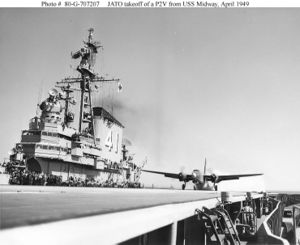
The Lockheed P-2 Neptune (until 1963 the P2V Neptune) was a naval patrol bomber and anti-submarine warfare (ASW) aircraft for the United States Navy between 1947 and 1978, replacing the PV-1 Ventura and PV-2 Harpoon and being replaced in turn with the P-3 Orion. Designed as a land-based aircraft, the Neptune never made a carrier landing, although a small number of aircraft were converted for carrier use and successfully launched. The type was successful in export, seeing service with several armed forces. The Neptune shares the P-2 designation (albeit under a different designation system) with the Curtiss P-2 Hawk, a much earlier biplane.
Contents
Design and development
Development began early in World War II, but was considered a low priority and it was not until 1944 that things really got going. A major factor in the design was ease of manufacture and maintenance, and this can be said to have been a major factor in the type's long life and worldwide success. The first aircraft flew in 1945. Production began in 1946, and the aircraft was accepted into service in 1947.
It was one of the first aircraft to be fitted in operational service with both piston and jet engines. The Convair B-36, several Boeing C-97 Stratofreighter, C-123 Provider, and Avro Shackleton aircraft also achieved that distinction; it leads naturally to an unusual sound during overflight.
"Truculent" Turtle
The third production P2V-1 was chosen for a record-setting mission, ostensibly to test crew endurance and long-range navigation but also for publicity purposes, to display the Navy's latest expensive plane. Loaded with fuel in extra tanks fitted in practically every spare space in the aircraft, the Turtle set out from Perth, Australia to the United States. The aircraft, invariably, seems to be called "Truculent Turtle" but, in fact, its name was simply "The Turtle"; which was painted on the aircraft's nose (along with a cartoon of a turtle smoking a pipe pedaling some device attached to a propeller). With a crew of four (and a nine month old gray kangaroo, a gift from Australia for the Washington, D.C zoo) the plane set off on September 9, 1946, with a RATO rocket-assisted takeoff. Two and a half days later, the Turtle touched down in Columbus, Ohio, 11,236.6 miles (18,083.6 km) from its starting point. It was the longest unrefuelled flight made to that point—4,000 miles (6,400 km) longer than the USAF's B-29 Superfortress record. This would stand as the absolute unrefueled distance record until 1962 (beaten by a USAF B-52 Stratofortress), and would remain as a piston-engined record until 1986 when Dick Rutan's Voyager would break it in the process of circumnavigating the globe.
Operational history
Vietnam War
During Vietnam War Neptune was used by the US Navy as a gunship and patrol airplane The Neptune was also utilized by the U.S. Army's 1st Radio Research Company (Aviation) located at Cam Ranh Bay.
Falklands War
The Argentine Navy received at least 16 Neptunes from different variants since 1958 including 8 ex Royal Air Force.
They were intensively used in 1978 during the Beagle crisis with Chile including over the Pacific Ocean [1].
In 1982, during the Falklands War (Spanish: Guerra de Malvinas ) the last two airframes in service (2-P-111 and 2-P-112) played a key role of reconnaissance and aiding Dassault Super Étendards, particularly on May 4 against HMS Sheffield. The lack of spare parts, the US placed an arms embargo in 1977 due the Dirty War, lead to the type being retired before the end of the war; Argentine Air Force C-130 Hercules took over the task of searching for targets for strike aircraft.
Other military operators
In Australia, Canada, the Netherlands and the US Navy its tasks were taken over by the much larger and more capable P-3 Orion and by the 1970s it was only in use by US reserve units. The US Naval Reserve abandoned its last Neptunes in 1978. By the 1980s, it had fallen out of use in most purchasing nations, replaced by newer aircraft.
In Japan, the Neptune was license-built from 1966 by Kawasaki as the P-2J, with the piston engines replaced by IHI turboprops. Kawasaki continued their manufacture much later than Lockheed did; the P-2J remained in service until 1984.
Civilian use
P-2/P2Vs are currently employed in aerial firefighting roles by operators such as Aero Union and Neptune Aviation Services and can carry 2,400 gallons of retardant with a service life of 15,000 hours. Neptune proposes to replace them with Bombardier Q200 and Q300 aircraft which are estimated to have a service life of 80,000 hours.
Variants
Lockheed produced seven main variants of the P2V. In addition, Kawasaki built the turboprop-powered P-2J in Japan. Model names after the 1962 redesignation are given in parentheses.
- XP2V-1 - prototype, one produced
- P2V-1 - first production model, 15 produced
- P2V-2 - 81 produced
- P2V-2N "Polar Bear - modified Neptune with ski landing gear, one produced.
- P2V-3 - upgraded powerplant, 83 produced
- P2V-3C - carrier-based Neptune, 11 produced
- P2V-3B - conversions from other P2V-3 models, 16 converted
- P2V-3W - search radar, 30 produced
- P2V-3Z - combat transport, two produced
- P2V-4 - 52 produced
- P2V-5 (P-2E) - 424 produced
- P2V-5F (AP-2E) - modification with J-34 jet engines
- P2V-5FD (DP-2E) - further modification of P2V-5F with target towing or drone launch capability
- P2V-5FE (EP-2E)
- P2V-5FS (SP-2E)
- OP-2E - modified gunship, only 12 existed
- P2V-5F (AP-2E) - modification with J-34 jet engines
- P2V-6 (P-2F) - aerial mine delivery, 83 produced
- P2V-6M - missile launch capability, 16 produced
- P2V-6F - modification with J-34 jet engines
- P2V-6T - trainer version
- P2V-7 (P-2H) - last Neptune variant produced by Lockheed, 311 produced
- P2V-7S
- P2V-7LP - ski landing gear
- AP-2H
United States Air Force
- RB-69A - aerial reconnaissance, seven produced
Japan Maritime Self Defense Force
- P2V-kai - Japanese variant produced by Kawasaki with turboprop engines, 82 produced
Operators
- Template:ARG: Argentine Navy (Escuadrilla Aeronaval de Exploracion) [2]
- Template:AUS: Royal Australian Air Force (10. & 11. RAAF Squadrons)
- Template:BRA
- Template:CAN: Royal Canadian Air Force (404., 405. & 407. RCAF Squadrons)
- Template:CHI
- Template:FRA: Aviation Navale
- Template:JPN
- Template:NLD
- Template:POR
- Template:UK: Royal Air Force (36., 203., 210. & 217. RAF Squadrons)
- Template:USA: USAF, US Navy
Specifications (P2V)
Template:Aircraft specification
References
- Sullivan, Jim, P2V Neptune in action. Squadron/Signal Publications: Carrollton, TX, 1985.
External links
- http://p2vneptune.com
- http://www.maam.org/neptune/p2_1.html
- http://frenchnavy.free.fr/aircraft/neptune/neptune.htm
- http://www.vpnavy.com/aircraft_p2_history.html
- http://www.vpnavy.com/turtle_01.html
- http://www.aerounion.com
- Missoulian article on Neptune's P2V water bombers and their proposed replacement with Q300s
- Listing of the carrier launch conversions
- http://www.VO-67.org Observation Squadron Sixty-Seven
Related content
Comparable aircraft
Designation sequence
| XB-68 | - | - | - | ||||
| SM-68 I | RB-69 | XB-70 | SR-71 | ||||
| SM-68 II | IM-69 | IM-70 | GAM-71 - XGAM-72 |
Related lists
Airliners and Civil Transports: Vega · Electra · Electra Junior · Super Electra · Lodestar · Constellation · Saturn · L-188 Electra · L-402 · JetStar · L-1011 TriStar
Military Transports : C-64 · C-121 · R6V · C-130 Hercules · C-141 Starlifter · C-5 Galaxy
Fighters: F-22 Raptor · F-35 Lightning II · F-94 Starfire · F-104 Starfighter · F-117 Nighthawk · P-38 Lightning · P-80 Shooting Star · T-33 Shooting Star
Patrol and reconnaissance : Hudson · PV-1 Ventura · PV-2 Harpoon · P-2 Neptune · P-3 Orion · CP-140 Aurora/CP-140A Arcturus · U-2 · SR-71 Blackbird · S-3 Viking
Lists relating to aviation | |
|---|---|
| General | Timeline of aviation · Aircraft · Aircraft manufacturers · Aircraft engines · Aircraft engine manufacturers · Airports · Airlines |
| Military | Air forces · Aircraft weapons · Missiles · Unmanned aerial vehicles (UAVs) · Experimental aircraft |
| Notable incidents and accidents | Military aviation · Airliners · General aviation · Famous aviation-related deaths |
| Records | Flight airspeed record · Flight distance record · Flight altitude record · Flight endurance record · Most produced aircraft |
de:Lockheed AP-2H it:Lockheed P2V Neptune ja:P-2 (航空機) pt:P-2 Neptuno tr:P-2 Neptune
